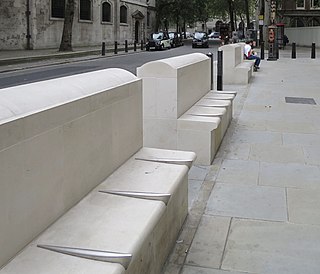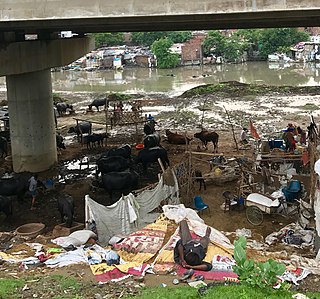
Homelessness in the United States refers to the issue of homelessness in the United States, a condition wherein people lack a fixed, regular, and adequate residence. The number of homeless people varies from different federal government accounts. In 2014, approximately 1.5 million sheltered homeless people were counted. In 2018, the Department of Housing and Urban Development estimated roughly 553,000 homeless people in the United States on a given night, or 0.17% of the population. Approximately 65% were sheltered in provided housing while 35% were unsheltered. Annual federal HUD reports contradict private state and local reports where homelessness is shown to have increased each year since 2014 across several major American cities, with 40 percent increases noted in 2017 and in 2019.

Homeless shelters are a type of homeless service agency which provide temporary residence for homeless individuals and families. Shelters exist to provide residents with safety and protection from exposure to the weather while simultaneously reducing the environmental impact on the community. They are similar to, but distinguishable from, various types of emergency shelters, which are typically operated for specific circumstances and populations—fleeing natural disasters or abusive social circumstances. Extreme weather conditions create problems similar to disaster management scenarios, and are handled with warming centers, which typically operate for short durations during adverse weather.
Supportive housing is a combination of housing and services intended as a cost-effective way to help people live more stable, productive lives, and is an active "community services and funding" stream across the United States. It was developed by different professional academics and US governmental departments that supported housing. Supportive housing is widely believed to work well for those who face the most complex challenges—individuals and families confronted with homelessness and who also have very low incomes and/or serious, persistent issues that may include substance use disorders, mental health, HIV/AIDS, chronic illness, diverse disabilities or other serious challenges to stable housing.

Out of 10,000 female individuals 13 are homeless. Although studies reflect that there are many differences among women suffering homelessness and there is no universal experience, the average homeless woman is 35 years old, has children, is a member of a minority community, and has experienced homelessness more than once in their lifetime.
A cooling center is an air-conditioned public space set up by local authorities to temporarily deal with the health effects of extreme heat weather conditions, like the ones caused by heat waves. Cooling centers are meant to prevent hyperthermia caused by heat, humidity, and poor air quality. Cooling centers provide shade, water, and restrooms; medical attention and referrals to social services may also be offered. Their services are aimed at the homeless, those without access to adequate air conditioning and at-risk populations such as the elderly, children and those with mental disability or chronic medical conditions.
Housing First is a policy that offers unconditional, permanent housing as quickly as possible to homeless people, and other supportive services afterward. It was first discussed in the 1990s, and in the following decades became government policy in certain locations within the Western world. There is a substantial base of evidence showing that Housing First is both an effective solution to homelessness and a form of cost savings, as it also reduces the use of public services like hospitals, jails, and emergency shelters. Cities like Helsinki and Vienna in Europe have seen dramatic reductions in homelessness due to the adaptation of Housing First policies, as have the North American cities Columbus, Ohio, Salt Lake City, Utah, and Medicine Hat, Alberta.
Transitional living refers to any type of living situation that is transitional. The primary purpose or mission of transitional living environments is temporary. Transitional living facilities often offer low cost housing. Transitional living residents that cater to those recovering from economic hardship often graduate from a shelter to lesser crowded living situation. Transitional living may or may not have other common threads among residents. Transitional living provides professional support, education, and a stable living environment. Common types of transitional living include transitioning from jail or prison, an addiction treatment center or a mental health facility. They may also target homelessness, especially among youth. Transitional living is provided by many well known private and non profit organizations, by government, churches and other charitable organizations.
Housing, or more generally, living spaces, refers to the construction and assigned usage of houses or buildings individually or collectively, for the purpose of shelter. Housing ensures that members of society have a place to live, whether it is a home or some other kind of dwelling, lodging or shelter. Many governments have one or more housing authorities, sometimes also called a housing ministry or housing department.

Homelessness or houselessness – also known as a state of being unhoused or unsheltered – is the condition of lacking stable, safe, and adequate housing. People can be categorized as homeless if they are:

Discrimination against homeless people is the act of treating homeless people, or people perceived to be homeless, unfavorably. As with most types of discrimination, it can manifest in numerous forms.
The Poverello Center, Inc. is a 501(c)(3) organization devoted to advocating for and providing a multitude of services to address and improve the health, well-being and stability of the homeless and under-served within Missoula, Montana.

A warming center is a short-term emergency shelter that operates when temperatures or a combination of precipitation, wind chill, wind and temperature become dangerously inclement. Their paramount purpose is the prevention of death and injury from exposure to the elements. This may include acute trauma from falling objects such as trees, or injury to extremities due to frostbite. A more prevalent emergency which warming centers seek to prevent is hypothermia, the risk for which is aggravated by factors such as age, alcohol consumption, and homelessness.
Berkeley Food and Housing Project is a nonprofit organization serving homeless men, women, and children in Berkeley, California and other parts of Northern California. BFHP is one of the largest homeless service providers in the East Bay.

Homelessness is a major issue in India. The Universal Declaration of Human Rights defines 'homeless' as those who do not live in a regular residence. The United Nations Economic and Social Council Statement has a broader definition for homelessness; it defines homelessness as follows: ‘When we are talking about housing, we are not just talking about four walls and a roof. The right to adequate housing is about security of tenure, affordability, access to services and cultural adequacy. It is about protection from forced eviction and displacement, fighting homelessness, poverty and exclusion. India defines 'homeless' as those who do not live in Census houses, but rather stay on pavements, roadsides, railway platforms, staircases, temples, streets, in pipes, or other open spaces. There are 1.77 million homeless people in India, or 0.15% of the country's total population, according to the 2011 census consisting of single men, women, mothers, the elderly, and the disabled. However, it is argued that the numbers are far greater than accounted by the point in time method. For example, while the Census of 2011 counted 46.724 homeless individuals in Delhi, the Indo-Global Social Service Society counted them to be 88,410, and another organization called the Delhi Development Authority counted them to be 150,000. Furthermore, there is a high proportion of mentally ill and street children in the homeless population. There are 18 million street children in India, the largest number of any country in the world, with 11 million being urban. Finally, more than three million men and women are homeless in India's capital city of New Delhi; the same population in Canada would make up approximately 30 electoral districts. A family of four members has an average of five homeless generations in India.

Outreach is the activity of providing services to any population that might not otherwise have access to those services. A key component of outreach is that the group providing it is not stationary, but mobile; in other words, it involves meeting someone in need of an outreach service at the location where they are. Compared with traditional service providers, outreach services are provided closer to where people may reside, efforts are very often voluntary, and have fewer, if any, enforceable obligations. In addition to delivering services, outreach has an educational role, raising the awareness of existing services. It includes identification of under-served populations and service referral and the use of outreach tools like leaflets, newsletters, advertising stalls and displays, and dedicated events. Outreach is often meant to fill in the gap in the services provided by mainstream services, and is often carried out by non-profit, nongovernmental organizations.

The San Francisco Bay Area comprises nine northern California counties and contains four of the ten most expensive counties in the United States. Strong economic growth has created hundreds of thousands of new jobs, but coupled with severe restrictions on building new housing units, it has resulted in an extreme housing shortage which has driven rents to extremely high levels. The Sacramento Bee notes that large cities like San Francisco and Los Angeles both attribute their recent increases in homeless people to the housing shortage, with the result that homelessness in California overall has increased by 15% from 2015 to 2017. In September 2019, the Council of Economic Advisers released a report in which they stated that deregulation of the housing markets would reduce homelessness in some of the most constrained markets by estimates of 54% in San Francisco, 40 percent in Los Angeles, and 38 percent in San Diego, because rents would fall by 55 percent, 41 percent, and 39 percent respectively. In San Francisco, a minimum wage worker would have to work approximately 4.7 full-time jobs to be able to spend less than 30% of their income on renting a two-bedroom apartment.
Mollie Ellen Lowery was an American advocate for homeless and mentally ill people in Los Angeles. In 1984, she co-founded the non-profit housing support center, LAMP, and in 2006 she founded an advocacy group, Housing Works.
The Dorothy Day shelter is a homeless shelter campus in Saint Paul, Minnesota, United States. The project is centered around the site of the Dorothy Day Center built in downtown Saint Paul in 1981. The shelter is named after American Catholic and social activist Dorothy Day. The Dorothy Day Center started as a drop-in center for meals to help the homeless population in downtown Saint Paul. The facility is operated by Catholic Charities of St. Paul and Minneapolis in coordination with Ramsey County, Minnesota.
Covenant House Toronto is a nonprofit organization that serves, at-risk, homeless and trafficked youth between the ages of 16 and 24. It is based in Toronto, Ontario, Canada and is one of many Covenant House locations based in North America. The Toronto location is the largest agency of its kind in Canada, with 80 per cent of their annual funding coming from donors. The house serves as many as 300 youth a day regardless of their race, religion, sexual orientation, gender identity, or the circumstances that have brought them to their doors. Covenant House also offers services such as education, after-care, counseling, health care, employment assistance, and job training. The organization has also offered their services to more than 95,000 young people since its start in 1982.

Columbus, the capital city of Ohio, has a history of social services to provide for low- and no-income residents. The city has many neighborhoods below the poverty line, and has experienced a rise in homelessness in recent decades. Social services include cash- and housing-related assistance, case management, treatment for mental health and substance abuse, and legal and budget/credit assistance.










